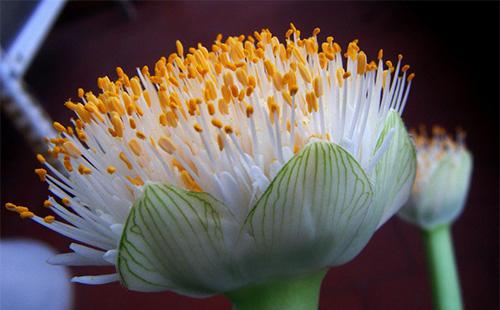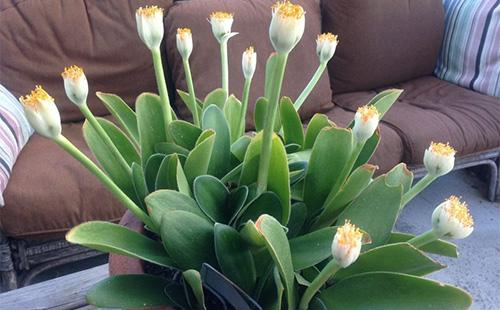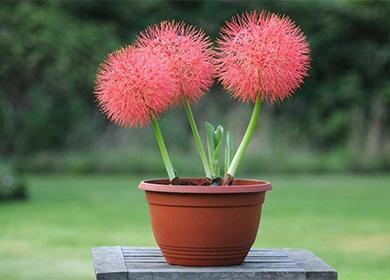The content of the article
The popular name for hemanthus is "deer tongue." He received such a nickname for the characteristic shape of the leaves. His inflorescences are also unusual - in the form of fluffy balls. For all its decorative features, hemanthus is an unpretentious plant, suitable not only for experienced gardeners, but also for beginners.
Botanical Description
Indoor flower hemanthus belongs to the same large genus of bulbous crops. Growth does not stop even in winter, foliage looks decorative and expressive. Two to three pairs of leaves appear from each bulb. Linguistic form - wide, slightly elongated, rounded and extended at the end. Leaves grow symmetrically, drooping on both sides of the pot. Depending on the variety, the surface of the foliage is glossy, slightly sticky or with slight pubescence.
Umbrella inflorescences rise on powerful peduncles. The inflorescence consists of small flowers (more than a hundred), covered with four bright bracts of the same shade. The colors are bright - in orange, red, sometimes white. Outwardly, the inflorescences look fluffy due to the many thin, long stamens. Some gardeners compare hemanthus flowers with lush pompons.
Popular views
In room culture, the most famous is the white-flowered hemanthus flower. The view with evergreen leaves is highly decorative and unpretentious. The leaves are slightly pubescent along the edge, loviform, wide, glossy. Peduncles short - no more than 25 cm. Inflorescences are white balls with long stamens. Based on the white-flowered hemanthus, breeders bred several hybrids with larger inflorescences.
Other types of hemanthus are less known, less common in home collections of gardeners. Some of them lose foliage during dormancy. Of particular interest among flower growers are eight varieties.
- Hemanthus red. Another name is cinnabar. The leaves are oval, underdeveloped. A red inflorescence forms on a long peduncle. It blooms early - around mid-April.
- Multi-flowered. Another early flowering variety. The leaves are veined, peduncles tall, ending with large inflorescences of pink or red.
- Pure white. Reminds hemanthus white-flowered. Differs in pubescence on the peduncle and the back of the leaves.
- Pomegranate. Variety with beautiful inflorescences up to 10 cm long. The leaves are leathery, with wavy edges, color - bright red.
- Brindle. Expressive variety with large leaves growing up to 25 cm. The color is green, at the base of the leaves are brown spots. Inflorescences of red color, rather large.
- Hemanthus Katarina. It is distinguished by the presence of a false stem about 15 cm long. Longer leaves are thinner than other varieties. The inflorescences are huge, red in color - they reach 20 cm in diameter. Blooms late - closer to autumn.
- Scarlet. Leaves more than half a meter long, reddish at the end. The flower stalk is strewn with spots, an inflorescence of red color with yellow anthers. Blooms rarely, mainly in autumn.
- Linden. A characteristic two-row arrangement of leaves on long petioles. Along the central vein, in the longitudinal direction, folds pass. Large inflorescences of a red hue rise on a long peduncle.

Hemanthus care in summer and winter
Proper care of white-flowered hemanthus at home implies the creation of a favorable microclimate, adherence to the feeding and watering schedule. Deer language is considered an unpretentious culture - for full growth, it needs minimal care.
- Lighting. The bright sun cannot stand the hemanthus, but needs intensive lighting. A shadow prevents the formation of a peduncle. They shade from the sun even on the eastern and western windows. Leaves quickly get burns, begin to turn white, die. In summer, the pot is rearranged on the balcony, providing protection from wind, rain and sun.
- Temperature. From the beginning of spring to late autumn, the haemanthus adapts to average room temperature. After flowering, a dormant period begins - in winter the deer tongue is kept in a cool place at a temperature of no higher than 15 ° C. Without a cold winter, there will be no flowering next summer. At any time of the year, air stagnation is not allowed - the room is ventilated daily.
- Watering. It is necessary to water the hemanthus sparingly: like all bulb plants, it does not tolerate moisture stagnation. Judging by the reviews of experienced gardeners, a flower tolerates a drought much easier than excessive dampness. Between watering, the soil in the pot should be half-dry. With the onset of the dormant period, watering is minimized - the substrate is almost completely dried. If the leaves begin to fade, water more often, but in moderation. Water is pre-settled.
- Humidity. Hemanthus does not need high humidity, so spraying is not practiced. But periodically carry out hygiene procedures - wipe the leaves with a damp cloth.
- Top dressing. Fertilizers are applied in a small amount. During the dormant period and after the appearance of the peduncle, they are not fed. In spring and summer, it is enough to feed the flower every three weeks with a weak solution of fertilizer.
- The soil. Choose nutritious and light soil. The best option is a ready-made substrate for bulb crops. The mixture is prepared independently from turf, deciduous, garden soil in equal quantities. To improve the quality of the substrate, some bone meal and peat are added.
- Transfer. Annual transplants are desirable. With slow growth, you can transplant hemanthus once every two years. The procedure is carried out at the very end of winter or at the beginning of spring. Transplanted carefully, trying not to injure the roots. Bulbs are not completely buried in the soil - only two-thirds.
Breeding methods
Even novice gardeners do not have problems with the reproduction of hemanthus. There are three ways in total.
- Child bulbs. Near the main bulb of an adult plant, children form. In the spring they can be planted in separate pots. Young plants will bloom only after three to four years.
- Seeds. Seeds sprout quickly, strong seedlings form. In most cases, the external characteristics of hybrid varieties are preserved. The only drawback is that the seeds quickly lose their germination. Therefore, sowing is started immediately after harvesting.
- Leaf. If the daughter bulbs have not yet formed or are not ready for transplantation, the hemanthus can be propagated by leaf. Separate the sheet with the base. The place of cut is sprinkled with coal powder, dried for about an hour. The cutlery is placed in a moistened substrate of sand and peat, covered with a jar. After a few weeks, small daughter bulbs appear at the base of the leaf.
Frequent florist errors
Despite the ease of care, when growing haemanthus, novice gardeners have to deal with problems - lack of flowering, slow growth, yellowing of leaves. All of these symptoms are the result of improper care. The most common mistakes of gardeners and the consequences can be seen in the table.
Table - Floriculture errors and consequences for hemanthus
| The appearance of the plant | The reasons | How to fix the problem |
|---|---|---|
| Hemanthus does not bloom | - Lack of rest period; - a spacious pot; - lack of trace elements; - waterlogging of the soil; - poor lighting | - Adjust care routine |
| White dots appeared on the leaves of the hemanthus | - Exposure to direct sunlight; - the appearance of pests; - spraying with hard water | - Inspect the hemanthus for pests; - shade from the sun; - stop spraying |
| Hemanthus leaves turn yellow | - excess moisture; - prolonged drying of the substrate; - the appearance of pests; - rotting bulbs | - Regulate the watering mode; - if necessary, the plant is transplanted |
| The buds are blackening | - The combination of high humidity and cold | - Gemantus rearrange in a warm place; - the soil is dried; - watered moderately |
| Hemanthus is slowly growing | - Lack of trace elements; - pest invasion | - Feed balanced fertilizer; - inspect for pests |
| Light plaque forms on the leaves. | - Watering hard water | - Water is pre-defended |
| Leaves stretch, brighten | - Lack of light | - Move to a more lighted place or install fluorescent lamps |
Common diseases
Hemanthus is often affected by fungal diseases. The main reason is non-compliance with the irrigation regime, high humidity, dense soil, lack of drainage. The most common diseases and methods for their treatment are described in the table.
Table - Hemanthus diseases
| Disease name | External manifestations | Treatment |
|---|---|---|
| Anthracnose | - Dark spots appear on the leaves; - at the ends of leaves dark brown streaks form | - Cut the affected leaves; - treated with a solution of "Fundazole" in a concentration of 1 g per 500 ml of water |
| Staganospore | - Onions appear small, rapidly spreading red spots; - lesions pass to the leaves; - the onion looks like it is boiled in boiling water | - In the initial stages of the disease, “Fundazol” is used. - in difficult cases, the onion and base of the leaves are coated with a paste of 100 g of chalk, 5 g of copper sulfate, 10 g of OP-7 and one and a half glasses of water |
| Gray rot | - A fluffy coating appears; - formed areas of necrotic rot | - In the early stages, they are treated with any systemic fungicide; - with a severe defeat, the plant is destroyed |

Typical pests
It is not always possible to protect hemanthus from pests. Amaryllis mealybug and spider mite cause particular harm. Detailed information on pests and methods of combating them can be studied in the table.
Table - Hemanthus pests
| Pest | External manifestations | Ways to fight |
|---|---|---|
| Amaryllis Worm | - Leaves turn yellow and fall: - hemanthus stops growing, looks depressed; - soot fungus joins | - In the initial stages of the lesion, water the soil with any systemic insecticide; - with a severe defeat, the diseased bulb is thrown away |
| Shield | - Brown plaques form on the surface of the stems and leaves; - leaves discolor, curl, dry | - Scaffold is removed with an alcohol towel; - the flower is sprayed with a solution of means "Actellic", "Decis" |
| Spider mite | - Light spots form on the leaves, gradually they merge into large, dried spots; - a spider web appears on the underside of the leaves | - Hemanthus is sprayed with Aktara, covered with a plastic bag for several hours |
| Thrips | - The leaves become silvery; - hemanthus withers, grows poorly | - Sprayed several times with any insecticide |
Proper care of the hemanthus includes moderate but timely watering, regular transplanting, special fertilizers, and frequent airing of the room. In favorable conditions, the plant blooms almost all summer and half autumn.

